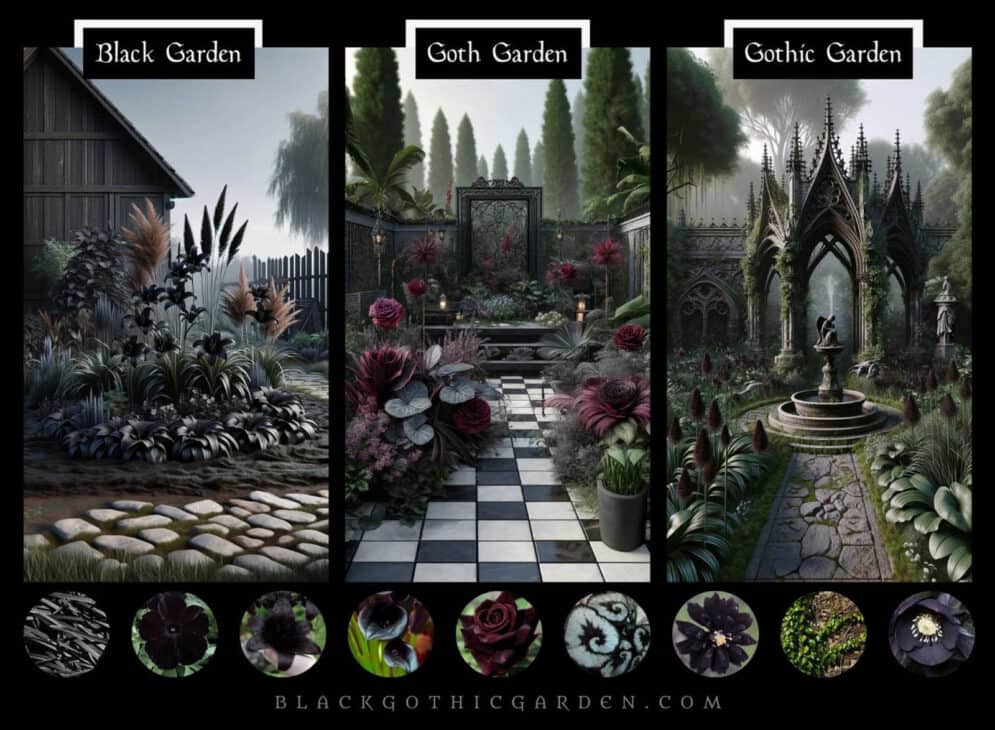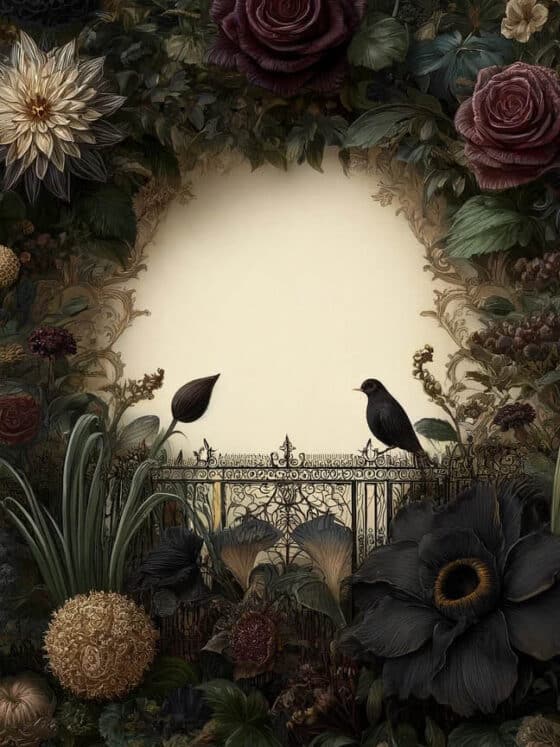What are the differences between a black garden, a goth garden, and a gothic garden? Are these terms simply interchangeable, or do they hold certain distinct nuances and design elements that set them apart? As someone who's deeply rooted in the goth and alternative subcultures, I've always been drawn to the allure of the color black. Hence, these types of gardens have captured my heart. But what if you don't feel any resonance to the goth subculture, nor the gothic art or historical architechture? Do you still have a goth garden? Let's discuss the unique connotations and inspirations of each type!
A disclaimer: These are my personal perspectives, and I also firmly think it's safe to use any of these terms to talk about a garden that has a bit darker aesthetics.
Share
Understanding the Differences: Black Garden, Goth Garden, and Gothic Garden
Understanding the distinctions between black gardens, goth gardens, and gothic gardens necessitates delving into the nuances of these terms and their stylistic influences. These garden styles, while possessing overlapping features, each carry unique connotations and design elements.
In order to grasp the distinctions, we must first grasp the key terms. The term “Goth” refers to a contemporary subculture that emerged from the post-punk music scene in the late 1970s. It is known for its unique style featuring dark fashion, makeup, and music with themes of sadness and the eerie. On the other hand, “gothic” refers to a historical and artistic movement that originated in the medieval period. It encompasses architecture, literature, and art, characterized by intricate and dramatic designs, as well as themes of secrecy, love, and the supernatural.
To summarize, I would outline the three garden types as follows:
- A black garden is a garden that focuses on black flowers and dark-leaved plants.
- A goth garden is a modern concept that emphasizes black and dark hues, rooted in contemporary goth aesthetics, combining plant colors with elements of modern goth culture.
- A gothic garden refers to a historical style that emphasized symmetry, architectural elements, and symbolic plants. Black flowers were not part of this style.
Next, I will describe these styles in more detail.

Black Garden
A black garden centers around flowers and foliage that are predominantly black or dark-hued. This garden style is all about creating a dark aesthetic by using black foliage, flowers, and even black hardscaping materials.
A black garden is more about color uniformity and less about cultural or historical references. You don’t need to be a goth nor have a goth garden to have a black garden.
Personally, my garden is the closest of a black garden, and simply having black flowers and plants is my first priority. Gothic elements come as a second priority.
Primary Focus: The core of a black garden lies in its monochromatic palette. This garden style is dedicated to plants and materials that are predominantly black or dark-hued. The aesthetic goal is to create a visually striking and somewhat somber environment.
Features:
– Plant Selection: Includes black or dark-hued plants such as Black Mondo Grass, Black Tulips and black varieties of Colocasia esculenta (especially if you live in a more tropical zone.)
– Hardscaping: Utilizes dark materials like black stones, slate pathways, and wrought iron for fences or garden structures.
– Design Philosophy: The emphasis is on color uniformity and dramatic contrast, with less reliance on cultural or historical references.
Goth Garden
A goth garden is a reflection of the modern goth subculture and the aesthetic that evolved alongside it, blending not only black flora but any elements that suit a dark and dramatic atmosphere. Originally, the term “goth” was deeply rooted in the music scene. Gothic music emerged in the late 1970s as a subgenre of post-punk, characterized by its melancholic, haunting sound and often macabre lyrics. Iconic bands like Bauhaus, Siouxsie and the Banshees, and The Cure led the goth movement, with their music embodying themes of melancholy and the allure of darkness.
While goth culture remains strongly connected to music for many, it has expanded into fashion, art, and lifestyle. Gothic imagery began to merge with goth music as lyrics painted visual landscapes inspired by gothic art and literature, drawing on dark themes, romance, and the supernatural. For instance, Bauhaus’s “Bela Lugosi’s Dead” references Bram Stoker’s Dracula and the actor Bela Lugosi, who famously portrayed Dracula. Inspired by these icons, goth bands increasingly infused their lyrics with gothic art’s core themes: loss, love, death, and mystery.
Today, the goth subculture has grown into a broad phenomenon, characterized by a dark aesthetic, distinctive fashion, and recurring themes.
A goth garden, in particular, offers more flexibility in plant selection than a purely black garden. Imagine dramatic roses that evoke vampire aesthetics, intricately patterned coleus or begonias, and statues that create a melancholic yet romantic ambiance. These gardens often feature plants in deep purples, reds, and blacks, creating a brooding yet captivating environment. The philosophy behind a goth garden emphasizes personal expression, rebellion against conventional norms, and the celebration of the macabre and unconventional beauty.
Primary Focus: A goth garden embodies the aesthetics and philosophy of the modern goth subculture, where gardening becomes a form of personal expression. This style reflects melancholy, rebellion, and dark beauty, much like how goth music captures the visual essence of gothic art and literature through its lyrics.
Features:
– Plant Selection: Dramatic roses, patterned coleus leaves, and plants with deep purples, reds, and blacks.
– Decorative Elements: Statues and features evoke a melancholic yet romantic vibe, often embodying themes from goth music, fashion, and art.
– Design Philosophy: Emphasizes brooding yet alluring environments, celebrating the macabre and dark beauty.
Gothic Garden
A gothic garden is a design style inspired by classic gothic architecture, literature and the art of both the medieval and Victorian eras. While we sometimes talk about goth and gothic as synonyms, gothic garden is distinct from the modern goth garden, which emphasizes a contemporary dark aesthetic and the use of black plants. In a purely gothic garden, the focus is not on colors but on symbolic architectural elements, a mystical atmosphere, and the merging of history and spirituality.
Medieval Gothic Gardens
In the Middle Ages, gothic gardens were often connected to monasteries or aristocratic estates, serving both spiritual and practical purposes. Symmetry and geometric shapes were essential elements, symbolizing order and harmony. Plants frequently had religious or medicinal significance—rosemary, lavender, and other herbs were not merely decorative but were used to treat illnesses and enhance spiritual well-being.
Architectural elements such as pointed arches and stone pathways were common features in medieval gothic gardens. Gothic style was present in every aspect: in the columns, walls, and vaulted arches reminiscent of cathedral structures. These gardens often contained shaded, secluded corners that symbolized the mystery of life and decay—themes that later became central in gothic literature and art.
Victorian and Gothic Revival Gardens
During the 19th century Gothic Revival movement, gothic architecture experienced a resurgence, influencing garden design, especially in Victorian England. Victorian gothic gardens were more ornate and symbolically rich than their medieval predecessors. They often featured intricate stone carvings, elaborate rose arches, and fountains, with a growing emphasis on the garden’s role as a symbol of the owner’s status and wealth.
Symmetry and grandeur were central themes in these Victorian gardens, but they also embodied the melancholic romance and transience associated with gothic aesthetics. Overgrown plants, weathered statues, and shadowy nooks created an atmosphere of mystery. These gardens focused less on practicality and more on their aesthetic and symbolic impact.
Creating a Modern Gothic Garden
Today, you can create a gothic garden by emphasizing its historical aesthetic and symbolism. Architectural elements such as pointed arch gates, wrought iron fences, and stone pathways are essential. Symmetry and dramatic shapes are key—consider designing walkways that lead to statues, water features, or hidden, shaded alcoves. Lighting is also crucial for creating the right gothic atmosphere. Use Victorian-style lanterns or soft lighting solutions to highlight specific areas of your garden.
While traditional gothic gardens did not include black flowers, a modern interpretation can incorporate dark-hued plants to set the mood. You might choose plants like purple-leaved elderberry, coleus, and dark roses, but remember that the essence of a gothic garden lies in its symmetry, architectural details, and the timeless sense of mystery it creates, rather than in a specific color palette.
Summary
While black gardens focus on the use of dark-hued plants and materials to achieve a unified aesthetic, goth gardens are tied to the modern goth subculture, integrating elements that reflect its macabre and romantic themes. Gothic gardens, however, draw from historical and architectural gothic styles, emphasizing grandeur, mystery, and the supernatural.
At the moment, the media tends to label all three as goth gardens, but if you want to be a bit more precise, now at least you know better what each of these garden types is like. 🙂
More to read:
Get the Mystery of a Gothic Garden for Yourself ( Houzz.com )




